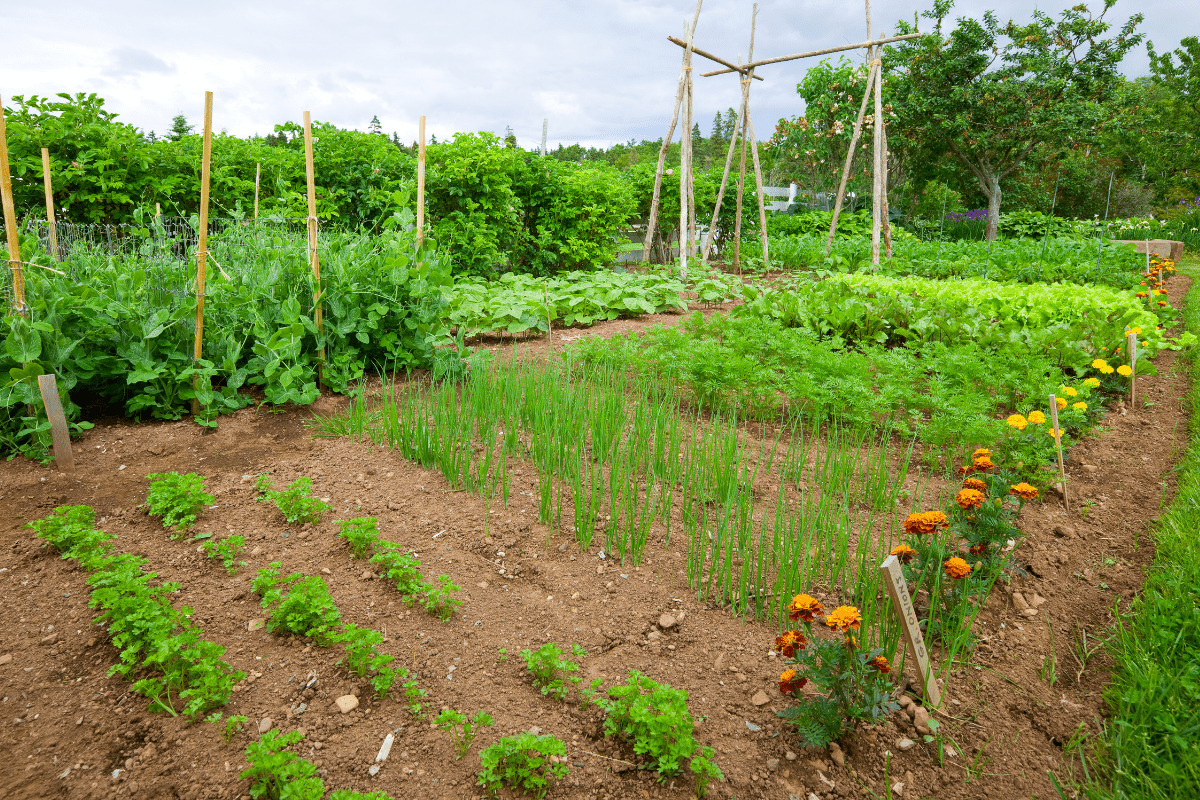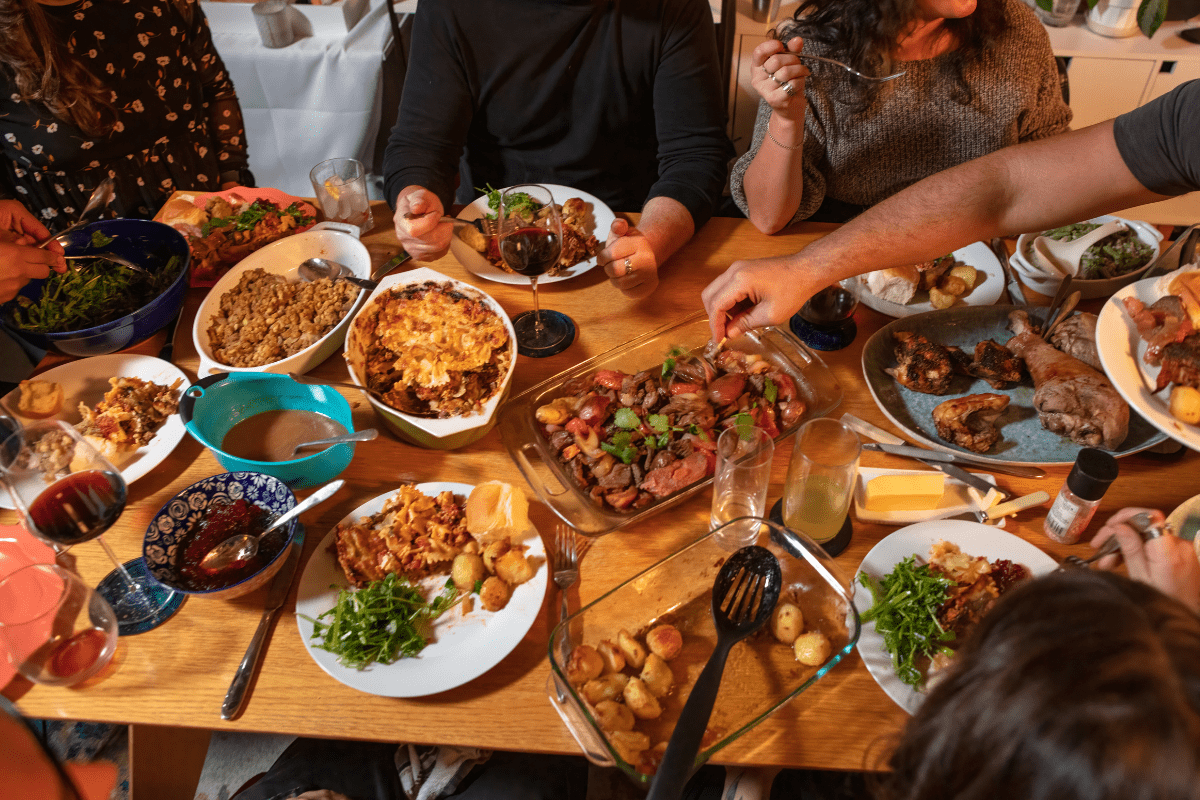Here's something that might surprise you: despite Indiana ranking as the 9th most valuable agricultural state, we import 98% of the fruits and vegetables we eat. That's right… we're surrounded by 15 million acres of farmland, yet most of our tomatoes come from California and our apples from Washington. The good news? Indiana's local food scene is blooming faster than sweet corn in July, and there's never been a better time to eat seasonally.
Understanding Indiana's growing zones (because Mother Nature doesn't care about county lines)
If you've been gardening with your grandma's planting calendar from 1985, I've got news for you. Indiana's climate zones have shifted northward faster than a flock of geese heading to Florida. The 2023 USDA update shows most of our state now sits comfortably in Zone 6, with some lucky ducks in southern river valleys enjoying Zone 7a temps.
What does this mean for your garden? Well, northern Indiana now gets 165-175 frost-free days instead of shivering through shorter seasons. Central Indiana enjoys 175-185 days of growing weather, while our southern neighbors are practically living in paradise with 190-200 days. Indianapolis even creates its own little tropical bubble… okay, not tropical, but the urban heat island effect does make it 2-4 degrees warmer than surrounding farmland.
When Jack Frost comes knocking
Let's talk frost dates, because nothing ruins a gardener's day quite like frozen tomato plants in May. Northern Indiana typically sees its last spring frost between April 25 and May 1. If you're itching to plant earlier, invest in some row covers or prepare for the walk of shame to the garden center for replacement plants.
Central Indiana gets a bit more wiggle room with last frosts hitting April 15-20, while southern Indiana practically gets a two-week head start with frost ending April 1-15. Fall tells a similar story in reverse, with first freezes arriving September 30 in the north but holding off until late October down south.
Your month-by-month guide to Indiana's seasonal offerings
Winter isn't as barren as you think
December through February might seem like the culinary equivalent of a barren wasteland, but innovative Indiana growers have other plans. Thanks to high tunnels and greenhouses, you can find fresh kale, spinach, lettuce, and Swiss chard at farmers markets year-round. Plus, those storage crops from fall… apples, potatoes, onions, and winter squash… are still going strong.
Spring awakening (April-May)
April brings more than just unpredictable weather and tax deadlines. Native wildflowers like spring beauty and bloodroot start the show, followed by the holy grail of spring vegetables: asparagus. Mark your calendar for April 23, when those first tender spears typically emerge. By May, strawberry season kicks off around the 20th, and suddenly everyone remembers why they put up with Indiana winters.
Spring also delivers:
- Fresh spinach and peas
- Rhubarb (for pie!)
- Native flower displays
- Reasons to skip grocery stores
Summer abundance (June-August)
This is when Indiana really shows off. June brings peak strawberry season from the 1st through 10th… and yes, you'll eat your body weight in berries and feel zero guilt. Sweet corn starts its glorious run July 1-5, followed closely by tomatoes around July 5-10.
By mid-July, the berry bonanza continues with raspberries and blackberries. August keeps the party going with more sweet corn than you can shake a cob at. Fun fact: Indiana sweet corn is so good, people from other states literally plan vacations around it. Okay, I made that up, but they should.
Fall harvest glory (September-November)
September through October is apple season, and Indiana doesn't mess around here. We're talking peak picking from September 1st through late October, with orchards offering everything from tart Jonathans to sweet Honeycrisps.
Here's where it gets interesting: Indiana ranks second nationally in pumpkin production. Those 7,100 acres of pumpkins generate $41 million annually, which explains why every third house has enough jack-o'-lanterns to guide small aircraft.
October also brings Indiana's secret weapons… pawpaws and persimmons. If you've never tried a pawpaw, imagine a banana and a mango had a baby in the Midwest. Persimmons need a good frost to sweeten up, making them nature's way of rewarding patient people.
Where to find all this seasonal goodness
Farmers markets: Your Saturday morning destination
Indianapolis alone hosts enough farmers markets to keep you busy every weekend. The Broad Ripple Farmers Market brings together 100+ vendors every Saturday from May through October. Can't make it to Broad Ripple? The Original Farmers Market at City Market offers a convenient downtown option.
Bloomington's Community Farmers Market transforms Tuesday evenings into a food festival from June through September. Even smaller communities get in on the action… Crown Point's farmers market regularly features 70+ vendors during peak season.
Top Indiana farmers markets:
- Indianapolis (multiple locations)
- Bloomington Community Market
- Fort Wayne neighborhood markets
- Crown Point Farmers Market
- Carmel, Fishers, Zionsville markets
U-pick farms: Where memories (and stains) are made
Nothing says "seasonal eating" quite like picking your own produce while your kids eat more than they put in the basket. Huber's Orchard & Winery in Borden offers the full experience with wagon rides and enough activities to exhaust even the most energetic children.
For berry lovers, check out:
- Garwood Orchards (300 acres!)
- Tanglewood Berry Farm
- Gingerich's Organic Strawberries
- Local listings at PickYourOwn.org
CSAs: Your weekly produce surprise box
Community Supported Agriculture programs connect you directly with local farms. Mad Farmers Collective in Indianapolis coordinates multiple farms to create diverse weekly boxes, while South Circle Farm proves you can grow serious vegetables just two miles from downtown. Find options at LocalHarvest or through Indiana CSA listings.
The local food infrastructure revolution
The Indiana Grown program now includes over 1,900 members, making it easier than ever to find local products. Food cooperatives like Bloomingfoods in Bloomington (8,000+ members strong) and Fort Wayne's 3 Rivers Food Co-op provide year-round access to local goods.
Mind-blowing Indiana agriculture facts
Ready for some statistics that'll make you the most interesting person at your next dinner party? Indiana doesn't just grow corn and soybeans. We're actually number one nationally in popcorn production. Yep, Orville Redenbacher started his empire right here in Brazil, Indiana.
We also lead the nation in:
- Commercial duck production (quack!)
- Decorative gourd cultivation (fall decor capital)
- Being generally agricultural overachievers
But wait, there's more! Indiana ranks second in both pumpkin and processing tomato production, and fifth in watermelon growing. Our floriculture industry generates $58 million annually, proving we can grow more than just food.
The real kicker? Despite all this agricultural abundance, only 1,456 farms grow vegetables for sale. That's just 2.7% of Indiana farms using a measly 0.25% of our farmland. The opportunity for growth is massive.
Getting expert help (because we all need it)
Purdue Extension: Your gardening lifeline
Purdue Extension specialist Rosie Lerner puts it perfectly: "Planting vegetable seeds or transplants at the correct time is determined by the soil temperature required for seeds to germinate." Translation: Stop planting by the calendar and start sticking a thermometer in your dirt.
The Indiana Vegetable Planting Calendar (publication HO-186-W) is basically the bible of Indiana gardening. Combine that with the Midwest Vegetable Production Guide, and you're armed with more knowledge than you'll know what to do with.
Master Gardeners: The volunteers who know everything
Indiana's Master Gardener program includes 2,705 active volunteers who contributed 168,399 hours in 2023… that's $4.8 million worth of free gardening advice. These folks have seen every pest, disease, and weather disaster Indiana can throw at a garden, and they're happy to share solutions.
Common challenges (and how to overcome them)
The pest parade
Just when your garden looks perfect, here come the uninvited guests. The latest party crasher is the spotted lanternfly, recently detected in southern Indiana. This invasive pest threatens grapes and fruit trees, joining our regular cast of aphids, cutworms, and various beetles.
The solution isn't reaching for the strongest pesticide at the store. Integrated pest management combines:
- Regular scouting (know thy enemy)
- Encouraging beneficial insects
- Targeted treatments only when needed
- Accepting that some damage is normal
Disease drama
Indiana's humidity is great for your skin but terrible for plant diseases. Fungal issues like powdery mildew and gray leaf spot thrive in our climate. The key is prevention through variety selection, crop rotation, and proper spacing for air circulation. Check out Purdue's disease resources for specific guidance.
Weather whiplash
Indiana weather is like a moody teenager… unpredictable and prone to extremes. Spring frost protection using row covers can save early plantings, while shade cloth helps during our inevitable August heat waves. For serious season extension, high tunnels can add 4-6 weeks to both ends of your growing season. The USDA offers cost-share programs covering up to 90% of installation costs.
Embracing Indiana's agricultural heritage
Native wisdom still works
The Native American Three Sisters planting method… corn, beans, and squash grown together… isn't just historical trivia. It's brilliant companion planting that still works today. Beans fix nitrogen while climbing corn stalks, and squash leaves shade the soil to retain moisture and suppress weeds. The Miami, Potawatomi, and Lenape tribes had this figured out centuries before permaculture became trendy.
Native plants for modern gardens
The Indiana Native Plant Society promotes plants that actually want to grow here. Wild bergamot, leadplant, and native grasses like big bluestem require minimal maintenance once established and support our struggling pollinator populations.
Well-adapted vegetable varieties for Indiana include:
- 'Stupice' tomatoes (early and cold-tolerant)
- 'Silver Queen' sweet corn (the classic)
- 'Blue Lake Bush' beans (reliable producer)
- Disease-resistant everything (humidity is real)
Don't forget the flowers
Indiana's flower farming scene is blooming… pun absolutely intended. Harvest Moon Flower Farm in Spencer offers u-pick flowers from July through September. Little Hill Flower Farm near Vincennes combines cut flowers with u-pick experiences. These aren't your grocery store bouquets… we're talking Instagram-worthy zinnias, sunflowers, and cosmos that'll make your neighbors jealous.
Season extension: Because who wants to stop in October?
High tunnels are game-changers for Indiana growers. These unheated greenhouse structures can extend your season 4-6 weeks on both ends, and the USDA cost-share programs make them surprisingly affordable. Communities like Argos are proving year-round production is possible in Indiana.
For smaller operations or home gardeners, try:
- Floating row covers (2-4°F protection)
- Cold frames (winter lettuce!)
- Succession planting (continuous harvests)
- Low tunnels over beds
Looking ahead: Indiana's food future
Climate projections suggest Indiana's growing season will extend by 3.5-4.5 weeks by mid-century. That's either exciting or terrifying, depending on your perspective. Smart growers are already experimenting with heat-tolerant varieties and water conservation techniques.
The local food movement keeps gaining steam. Events like Local Food Week in Northeast Indiana feature 90+ events each July. Combined with recent supply chain disruptions teaching us the value of local resilience, the future looks bright for Indiana's seasonal food system.
Time to dig in
Whether you're planning your first garden, searching for the perfect farmers market, or just wanting to eat more seasonally, Indiana offers incredible opportunities. Only 2.7% of our farms currently grow vegetables for sale… imagine what our food landscape could look like if we doubled that number.
Start small. Visit a farmers market this weekend. Try one new vegetable you've never cooked before. Plant some lettuce in a container. Join a CSA. Every small action helps build a stronger local food system while connecting you to Indiana's agricultural heritage.
After all, in a state that grows everything from pawpaws to popcorn, from decorative gourds to world-class sweet corn, why are we importing 98% of our produce? It's time to eat like Hoosiers… seasonally, locally, and with plenty of sweet corn on the side.





